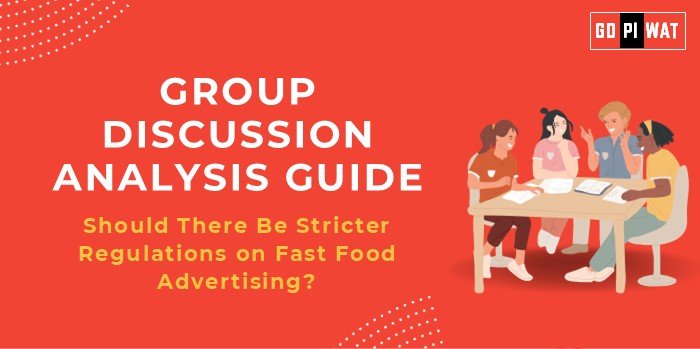📋 Group Discussion Analysis Guide: Should There Be Stricter Regulations on Fast Food Advertising?
🌐 Introduction to the Topic
Fast food advertising, a multi-billion-dollar industry, significantly influences dietary habits, particularly among children and adolescents. As obesity and diet-related illnesses rise globally, stricter regulations on fast food advertising have sparked intense debate, balancing public health interests and corporate freedoms.
📊 Quick Facts and Key Statistics
– 👶 Children’s Exposure: On average, children in the U.S. see over 10,000 food advertisements yearly, 80% promoting fast foods.
– ⚖️ Obesity Rates: 39% of adults worldwide are overweight, with 13% obese, linked to unhealthy diets.
– 💰 Marketing Spending: Fast food companies spent $5 billion on U.S. advertising in 2022.
🤝 Stakeholders and Their Roles
- 🏛️ Governments: Enforce advertising standards to protect public health.
- 🍔 Fast Food Corporations: Drive economic growth but face criticism for targeting vulnerable populations.
- 💡 Public Health Organizations: Advocate for tighter controls to curb obesity rates.
- 🧑🤝🧑 Consumers: Balance awareness with personal responsibility for health choices.
🏆 Achievements and Challenges
✨ Achievements
- ✅ Self-Regulation by Companies: Initiatives like reducing sugary drink ads for children.
- 🌍 Success Stories: Norway and Chile restrict fast food marketing effectively, reducing unhealthy food consumption.
- 📣 Consumer Awareness Campaigns: Highlighting health risks of excessive fast food.
⚠️ Challenges
- 🔍 Loopholes in Advertising Standards: Companies often exploit digital platforms to target minors.
- 🌎 Global Disparities: Developing nations have weaker regulatory frameworks.
- 💼 Resistance from Industry: Economic concerns hinder stricter regulations.
💬 Structured Arguments for Discussion
Supporting Stance: “Fast food advertising directly influences dietary habits, contributing to rising obesity and healthcare costs.”
Opposing Stance: “Stricter regulations infringe on corporate freedom and consumer choice.”
Balanced Perspective: “While consumer choice matters, targeted advertising to children necessitates tighter oversight to protect public health.”
📚 Effective Discussion Approaches
- 📊 Opening Approaches:
- 💡 Statistic-Based: “In 2023, fast food advertising spending exceeded $5 billion, directly shaping consumer habits globally.”
- ❓ Problem Statement: “With 39% of adults overweight, can fast food advertising continue unchecked?”
- 🤝 Counter-Argument Handling:
- 💬 Rebuttals: “Though corporations argue economic harm, health costs due to obesity far outweigh advertising gains.”
🔍 Strategic Analysis of Strengths and Weaknesses
– 🤔 Weaknesses: Economic pushback and implementation hurdles.
– 🌟 Opportunities: Global precedent in countries like Chile and Norway.
– ⚠️ Threats: Industry lobbying and legal challenges.
📈 Connecting with B-School Applications
- 🌍 Real-World Applications: Exploring marketing ethics, public health initiatives, or economic impacts for projects.
- ❓ Sample Questions:
- 💬 “How can advertising ethics influence consumer health positively?”
- 💡 “Evaluate the economic implications of regulating fast food marketing.”


